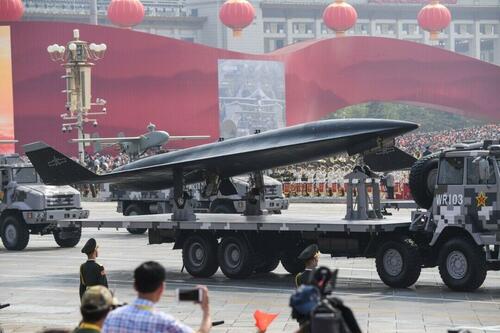Authored by Antonio Graceffo via The Epoch Times,
The White House has released the first-ever U.S. artificial intelligence (AI) strategy, developed to counter China’s ambitions to lead AI development globally and leverage it across military and civilian sectors for strategic dominance.
On Oct. 24, the White House issued the National Security Memorandum (NSM) on Artificial Intelligence (AI), underscoring the urgent need for the United States to lead in AI governance and set global standards for security, transparency, and ethical use. This initiative seeks to counter the Chinese Communist Party’s (CCP’s) efforts to dominate the AI field.
Through initiatives like the Belt and Road Initiative and aggressive tactics within organizations such as the World Trade Organization, the United Nations, and the Permanent Court of Arbitration, the CCP has shown its intent to reshape international rules in ways that favor Beijing’s interests, often disregarding established global norms. Allowing China to dictate AI standards could have far-reaching and severe consequences globally.
The AI threat from the Chinese regime to U.S. national security is substantial and complex, involving China’s integration of AI across both civilian and military sectors as part of its long-term strategy. White House national security adviser Jake Sullivan has voiced concerns over China’s use of AI for internal surveillance and misinformation campaigns, which are now being exported and pose threats to U.S. and allied security.
A key component of Beijing’s AI strategy is the “intelligentization“ of its military, aiming to use AI for advanced decision-making and autonomous systems, which could give the regime a strategic military advantage in ways that the United States may struggle to counter.
China’s AI-powered military advancements include deploying unmanned aerial vehicles (UAVs) and uncrewed surface vessels (unmanned naval drones), as well as enhancing command and control operations. These capabilities could disrupt U.S. intelligence operations or destabilize military power balances in sensitive regions like the Taiwan Strait. Such risks highlight the urgency for the United States to monitor and counter these developments, as China’s rapid AI integration could make predicting and countering its moves increasingly difficult.
Some analysts believe that AI will be so crucial in future wars that, without it, the U.S. military might be unable to defeat the Chinese military, the People’s Liberation Army. The recent U.S. memorandum directs defense and national security agencies to incorporate AI in defense, intelligence, and counterintelligence operations. The White House emphasizes integrating AI into national security while protecting AI resources from foreign threats, with a particular focus on mitigating risks like technology transfer and espionage in the AI supply chain. The NSM further prioritizes intelligence gathering on competitor activities in the U.S. AI sector to counter economic and technological espionage targeting American AI leadership.
China’s national AI strategy prioritizes advancements in AI technology and active participation in global AI governance. Central to this strategy is military-civil fusion, where civilian AI advancements are rapidly applied to military technology, giving China a strategic advantage in innovation and resource use. While the U.S. government is also funding AI development, and the recent memorandum aims to integrate AI into intelligence and defense to maintain competitiveness and prevent AI-based operational advantages for China, especially in cyber and autonomous warfare, China may still be outpacing the United States in certain critical areas.
“The 2023 National Security Scorecard: Critical Technologies Edition” report from Govini offers an in-depth look at the U.S.–China rivalry in key technologies essential to national security. It highlights vulnerabilities in U.S. defense due to a heavy reliance on Chinese suppliers, especially in AI. The report indicates that China now leads the United States in AI innovation, as evidenced by its high patent output and robust development of machine learning applications that impact both military and civilian sectors. This growing gap underscores the need for the United States to strengthen its AI research and development, secure its supply chains, and lessen its dependence on technology from adversarial sources, such as communist China, to maintain a strategic edge in national security.
Alongside enhancing its AI capabilities, the United States must encourage its allies to strengthen their own. Speaking at the National Defense University on Oct. 24, Sullivan stressed the importance of international partnerships to provide secure alternatives to China’s AI-powered digital infrastructure, which poses risks of data compromise, surveillance, and censorship. He cautioned that reversing course can be difficult and costly once nations adopt China’s technology.
The White House asserts that achieving U.S. dominance in AI requires both public and private collaboration to drive innovation, secure AI talent, and maintain computational advantages. Key initiatives include strengthening domestic AI research, enhancing cybersecurity, and ensuring a secure AI ecosystem. The CHIPS Act boosts U.S. capacity in advanced chip production critical for AI, while recent policies restrict China’s access to AI-enabling semiconductor technology to slow its military advancements.
Although non-defense research funding has decreased in recent years, the Biden administration is coordinating with Congress to secure resources to improve AI capabilities, such as government supercomputers and supply chain security for semiconductor production. Without these measures, experts warn that China’s rapid AI adoption could shift military power in its favor, especially in contested regions like Taiwan.
To counter the CCP’s AI threat, the Center for a New American Security (CNAS) advises that the U.S. bolster its military AI capabilities, establish norms for responsible AI use in defense, and work closely with allies on these issues. CNAS recommends negotiating risk reduction and confidence-building measures with China specifically for military AI while simultaneously pursuing broader crisis management frameworks.
Additionally, CNAS suggests integrating military AI into diplomatic efforts on nuclear and strategic stability with China, addressing risks from AI’s rapid, unpredictable nature, and prioritizing intelligence on China’s military AI advancements.
Views expressed in this article are opinions of the author and do not necessarily reflect the views of The Epoch Times or ZeroHedge.
